Moses Fowler House
The Moses Fowler House is located at the corner of 10th and South Streets in Lafayette, Indiana. The Fowler house is considered the finest example of a large Gothic Revival residence still standing in the United States. Upon his death in 1889, Fowler had accumulated a fortune of several million dollars. Moses Fowler and his wife Eliza were donors to various community interests including Purdue University. Eliza Fowler Hall (razed) at Purdue University was named in honor of Eliza Fowler.[2]
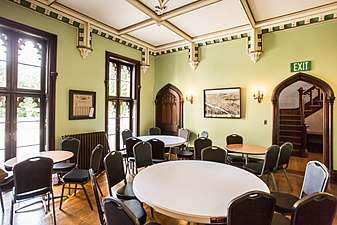

Moses Fowler House | |
   | |
| Location | Corner of 10th and South Sts., Lafayette, Indiana |
|---|---|
| Coordinates | 40°25′0″N 86°53′10″W |
| Area | less than one acre |
| Built | 1852 |
| Architectural style | Gothic Revival |
| NRHP reference No. | 71000009[1] |
| Added to NRHP | August 5, 1971 |
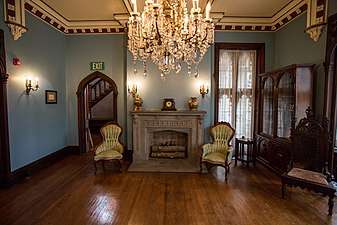
The house was built by Moses Fowler in 1851-1852. Locally harvested Black Walnut and White Oak were used for the ornately carved woodwork. Italian immigrant craftsmen were brought via the Wabash and Erie Canal from New York City to execute the elaborate decorative plaster work ceilings in the large north and south parlors. When completed it was one of the finest houses in Indiana. The designs for the house were principally taken from a copy of A.J. Downing’s book The Architecture of Country Houses c.1851 which Moses purchased while on a business trip in New York City.
Fowler originally came to Lafayette in 1839 from Circleville, Ohio with his friend and business partner John Purdue (founder of Purdue University) and engaged in the dry goods business. Over the years a number of business pursuits made him very wealthy. These included the wholesale business, cattle ranching, the railroads, and banking, At his death in 1889, Fowler had accumulated a fortune of several million dollars. Following his death, his wife Eliza was a generous donor to various community interests including Purdue University. Eliza Fowler Hall (razed) at Purdue University was named in her honor.[2]
In 1902, Moses Fowler's grandson, Cecil G. Fowler, inherited the house and he and his wife Louise made it their residence. Cecil had followed his father and grandfather into banking but was also a developer. He partnered with Carl Fischer (developer of the Indianapolis Motor Speedway) to build the first luxury hotel in Miami Beach, Florida, which opened on New Year's Eve 1920. In 1916-17, the Fowlers moved out of the house while significant renovations and additions were completed. During this time a large Tudor style formal dining room and living room were added, along with an indoor kitchen, laundry, garage, and servants quarters. The upstairs now included seven bedrooms and five bathrooms. These included a new guest bedroom, master suite, and servants bedrooms. Outside, a large Italian style tiered patio with fountains, a reflecting pool, a tea house, and formal gardens were added. The Fowlers loved to entertain and were well known locally for the large and extravagant parties they hosted. In 1940, with their children grown, the Fowlers sold the house to the Tippecanoe County Historical Association.
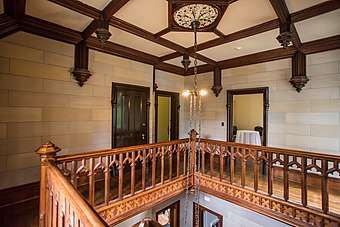
From 1940 until 2015, the Moses Fowler House was the home of the Tippecanoe County Historical Association and used at various times as a museum, offices, and for collections storage.
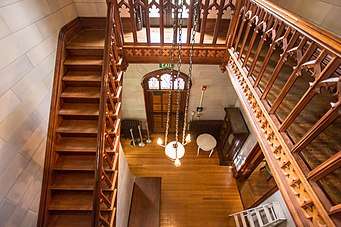
In 2015, The 1852 Foundation (a 501c3 non-profit public charity) was founded through the generosity of Matt and Dr. Ann Jonkman.[3] The 1852 Foundation purchased the Fowler House Mansion and from 2015-2018 completed over $1.3 million in restorations, repairs, code updates, and facility additions in order that the house could be open to and used by the public for tours and as an events venue.
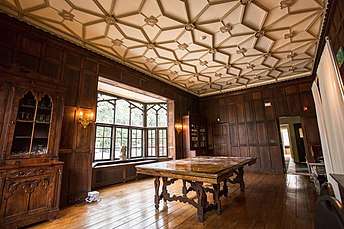
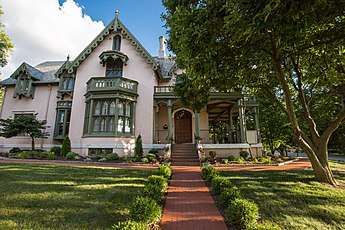
References
- "National Register Information System". National Register of Historic Places. National Park Service. March 13, 2009.
- "Indiana State Historic Architectural and Archaeological Research Database (SHAARD)" (Searchable database). Department of Natural Resources, Division of Historic Preservation and Archaeology. Retrieved 2016-07-01. Note: This includes Clark Dobbs and William Baugh (December 1970). "National Register of Historic Places Inventory Nomination Form: Moses Fowler House" (PDF). Retrieved 2016-07-01. and Accompanying photographs
- "Sold! Historic Moses Fowler House has new ownership". WLFI. June 11, 2015. Retrieved 23 December 2015.
Further reading
- Indiana Houses of the Nineteenth Century by Wilbur Peat, copyright 1962. pages 88.
- Historic American Buildings Survey in Indiana, edited by Thomas M. Slade, copyright 1983, page 122. ISBN 0-253-32741-5


